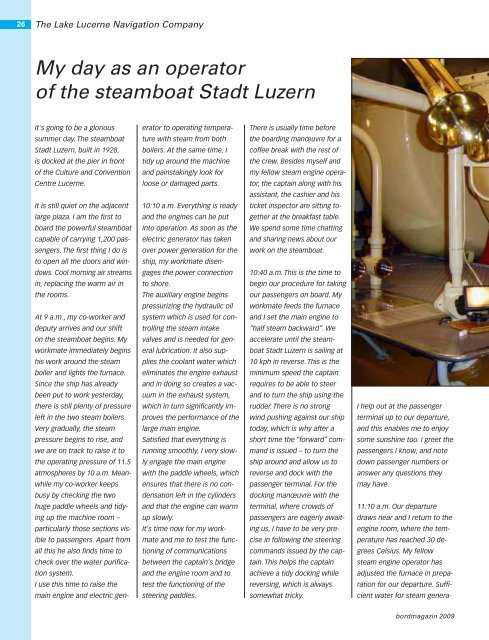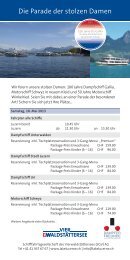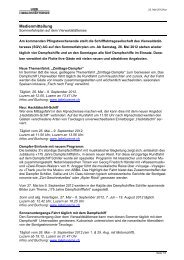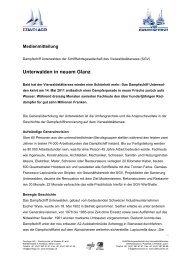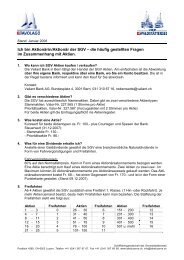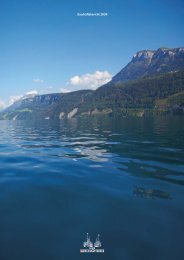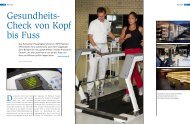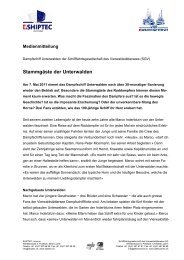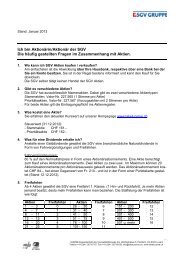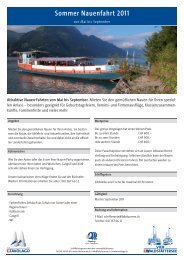LUZERN: Blick hinter die Postkartenseiten SCHWEIZER MARINE ...
LUZERN: Blick hinter die Postkartenseiten SCHWEIZER MARINE ...
LUZERN: Blick hinter die Postkartenseiten SCHWEIZER MARINE ...
Erfolgreiche ePaper selbst erstellen
Machen Sie aus Ihren PDF Publikationen ein blätterbares Flipbook mit unserer einzigartigen Google optimierten e-Paper Software.
26<br />
The Lake Lucerne Navigation Company<br />
My day as an operator<br />
of the steamboat Stadt Luzern<br />
It's going to be a glorious<br />
summer day. The steamboat<br />
Stadt Luzern, built in 1928,<br />
is docked at the pier in front<br />
of the Culture and Convention<br />
Centre Lucerne.<br />
It is still quiet on the adjacent<br />
large plaza. I am the first to<br />
board the powerful steamboat<br />
capable of carrying 1,200 passengers.<br />
The first thing I do is<br />
to open all the doors and windows.<br />
Cool morning air streams<br />
in, replacing the warm air in<br />
the rooms.<br />
At 9 a.m., my co-worker and<br />
deputy arrives and our shift<br />
on the steamboat begins. My<br />
workmate immediately begins<br />
his work around the steam<br />
boiler and lights the furnace.<br />
Since the ship has already<br />
been put to work yesterday,<br />
there is still plenty of pressure<br />
left in the two steam boilers.<br />
Very gradually, the steam<br />
pressure begins to rise, and<br />
we are on track to raise it to<br />
the operating pressure of 11.5<br />
atmospheres by 10 a.m. Meanwhile<br />
my co-worker keeps<br />
busy by checking the two<br />
huge paddle wheels and tidying<br />
up the machine room –<br />
particularly those sections visible<br />
to passengers. Apart from<br />
all this he also finds time to<br />
check over the water purification<br />
system.<br />
I use this time to raise the<br />
main engine and electric gen-<br />
erator to operating temperature<br />
with steam from both<br />
boilers. At the same time, I<br />
tidy up around the machine<br />
and painstakingly look for<br />
loose or damaged parts.<br />
10:10 a.m. Everything is ready<br />
and the engines can be put<br />
into operation. As soon as the<br />
electric generator has taken<br />
over power generation for the<br />
ship, my workmate disengages<br />
the power connection<br />
to shore.<br />
The auxiliary engine begins<br />
pressurizing the hydraulic oil<br />
system which is used for controlling<br />
the steam intake<br />
valves and is needed for general<br />
lubrication. It also supplies<br />
the coolant water which<br />
eliminates the engine exhaust<br />
and in doing so creates a vacuum<br />
in the exhaust system,<br />
which in turn significantly improves<br />
the performance of the<br />
large main engine.<br />
Satisfied that everything is<br />
running smoothly, I very slowly<br />
engage the main engine<br />
with the paddle wheels, which<br />
ensures that there is no condensation<br />
left in the cylinders<br />
and that the engine can warm<br />
up slowly.<br />
It’s time now for my workmate<br />
and me to test the functioning<br />
of communications<br />
between the captain’s bridge<br />
and the engine room and to<br />
test the functioning of the<br />
steering paddles.<br />
There is usually time before<br />
the boarding manœuvre for a<br />
coffee break with the rest of<br />
the crew. Besides myself and<br />
my fellow steam engine operator,<br />
the captain along with his<br />
assistant, the cashier and his<br />
ticket inspector are sitting together<br />
at the breakfast table.<br />
We spend some time chatting<br />
and sharing news about our<br />
work on the steamboat.<br />
10:40 a.m. This is the time to<br />
begin our procedure for taking<br />
our passengers on board. My<br />
workmate feeds the furnace<br />
and I set the main engine to<br />
“half steam backward”. We<br />
accelerate until the steamboat<br />
Stadt Luzern is sailing at<br />
10 kph in reverse. This is the<br />
minimum speed the captain<br />
requires to be able to steer<br />
and to turn the ship using the<br />
rudder. There is no strong<br />
wind pushing against our ship<br />
today, which is why after a<br />
short time the “forward” command<br />
is issued – to turn the<br />
ship around and allow us to<br />
reverse and dock with the<br />
passenger terminal. For the<br />
docking manœuvre with the<br />
terminal, where crowds of<br />
passengers are eagerly awaiting<br />
us, I have to be very precise<br />
in following the steering<br />
commands issued by the captain.<br />
This helps the captain<br />
achieve a tidy docking while<br />
reversing, which is always<br />
somewhat tricky.<br />
I help out at the passenger<br />
terminal up to our departure,<br />
and this enables me to enjoy<br />
some sunshine too. I greet the<br />
passengers I know, and note<br />
down passenger numbers or<br />
answer any questions they<br />
may have.<br />
11:10 a.m. Our departure<br />
draws near and I return to the<br />
engine room, where the temperature<br />
has reached 30 degrees<br />
Celsius. My fellow<br />
steam engine operator has<br />
adjusted the furnace in preparation<br />
for our departure. Sufficient<br />
water for steam genera-<br />
bordmagazin 2009<br />
Measuring instruments.<br />
tion has been fed into the<br />
boilers. At 230 degrees Celsius,<br />
we now have enough hot<br />
steam for our departure.<br />
The large steam whistle at the<br />
smokestack announces our<br />
immediate departure. My captain<br />
gives the “full steam<br />
ahead” command and lets me<br />
know how many passengers<br />
we have on board. I use this<br />
information to adjust the power<br />
output of the steam engine<br />
and calculate our required<br />
travel speed so that we can<br />
bordmagazin 2009<br />
avoid delays. If we have a lot<br />
of passengers, this affects our<br />
embarking and disembarking<br />
times considerably. We compensate<br />
for this by increasing<br />
our cruising speed accordingly.<br />
Faster cruising requires<br />
more steam pressure, which<br />
my workmate regulates by adjusting<br />
precisely how much he<br />
feeds into the furnace that<br />
heats the boiler. Every ten to<br />
fifteen minutes we dock at a<br />
stop, and this ensures that<br />
we are kept busy during the<br />
The Lake Lucerne Navigation Company<br />
five-and-a-half-hour round<br />
trip from Lucerne to Flüelen.<br />
We take turns eating lunch<br />
in between stops, but when<br />
it comes time to perform<br />
manœuvres with the machine<br />
again, both steam engine<br />
operators need to be at their<br />
posts.<br />
During the course of the<br />
whole trip I go around and<br />
keep checking the engines.<br />
For instance I sometimes refill<br />
the lubricant reservoir for<br />
cylinder lubrication or perform<br />
minor repairs on the little<br />
workbench in the engine<br />
room with my workmate.<br />
4:47 p.m. We are back in<br />
Lucerne with the steamboat<br />
Stadt Luzern.<br />
As soon as the passengers<br />
have disembarked, my workmate<br />
reconnects the power<br />
connection to the mainland.<br />
We switch the power back<br />
from generator to mains, then<br />
power down the generator,<br />
the main engine and auxiliary<br />
engine. We use a hydraulic<br />
hose to pump the collected<br />
sewage into the sewer system.<br />
Meanwhile the furnace<br />
has been put out at the steam<br />
boiler and all steam valves at<br />
the boiler dome have been<br />
shut off. No further steam can<br />
escape now. The last few<br />
squirts of oil are cleaned off<br />
the engine and the engine<br />
room floor is cleaned to avoid<br />
someone slipping and having<br />
an accident.<br />
At the end of a hard day we<br />
enjoy a cool beer with our<br />
workmates on the deck. This<br />
is when we get to hear about<br />
all those funny, interesting or<br />
otherwise notable events of<br />
the day that are hidden from<br />
us engine operators while we<br />
work below deck.<br />
Somewhat tired, but filled<br />
with the satisfaction of having<br />
served another lot of happy<br />
passengers, I head home. Full<br />
of expectation I look forward<br />
to the next day, since no one<br />
day is like any of the others.<br />
Heimo Haas,<br />
Steam Engine Operator<br />
Fotos: SGV<br />
27


